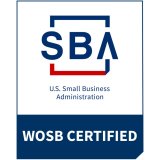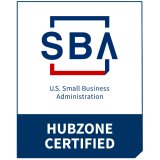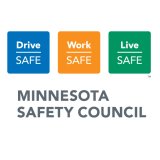Have a question about CavCom products or hearing conservation services? Feel free to check out our frequently asked questions below, or call us at: 866-547-4988. Click any category below to expand.

Talk Through Your Ears®
- How does Talk Through Your Ears® work?
CavCom‘s innovative Talk Through Your Ears® technology captures speech from inside the ear canal and propagates that speech into clear, intelligible voice communications even in high noise environments. Since the speech is captured deep inside the ear canal, CavCom earpieces physically block ambient noise (providing superior hearing protection) and transmit the speech signal before it can be overwhelmed by background noise. As long as you are receiving adequate hearing protection, you will achieve clear communications.
- Does CavCom‘s Talk Through Your Ears® system work off bone conduction?
No - CavCom‘s Talk Through Your Ears® technology captures acoustic voice signals present in the earcanal. So-called "bone conduction" microphones pick up physical vibrations via direct contact with body tissues.
- Does the Talk Through Your Ears® system require an FCC license?
No. The CavCom Talk Through Your Ears® system is an accessory to your two-way radio. Your two-way radio, however, must be operated under an FCC license. Please contact CavCom @ 1-866-547-4988 for assistance.
- Does CavCom offer an intrinsically safe option?
Yes, CavCom‘s PTT2000-NC5-1 Control Unit is certified intrinsically safe in accordance with ANSI/UL 913 and CAN/CSA-C22.2 standards (Class 1). More information
- What is the difference between listening with one ear (monaural) vs. listening with both ears (binaural)?
For most people, binaural listening is superior. It probably comes as no surprise that just like vision is improved with two eyes, hearing is improved with two ears (and all the neural processing in between). Much research has been conducted on the combined effects of listening binaurally. The brain's processing of subtle differences in the time and level of signals coming from each ear provide for the ability to localize (tell which direction sounds are coming from). In addition, sounds don't need to be as loud when listening binaurally, especially in the presence of complex background noise. See CavCom‘s SoundBytes series to learn more: Effective 2-way Communication and Special Considerations for Workers with Hearing Loss.
- What does “volume-limited output” mean?
CavCom was founded on a commitment to improve workplace safety and productivity through innovative hearing protection and 2-way communication products. In addition to hazardous background noise, 2-way radios and lapel speaker mics can also be quite loud, potentially adding to workplace noise exposures. CavCom‘s goal from our first manufacturing run in 1997 was to limit volume outputs from 2-way radios by way of our accessories. Our volume-limited earsets produce significantly lower sound levels than typical accessories, particularly single-ear listening devices.
Output level is only one factor affecting potential risk to hearing. In addition to how loud a sound is, it's important to know how long and how often the exposure occurs. Controlling all factors will help reduce the risk of over-exposure.
When purchasing a personal communication device, CavCom recommends companies take into account 3 important features:
- Binaural (both ear) listening provides significant hearing advantages
- Output-limited accessories promote safer listening levels
- Adequate hearing protection is essential in order to minimize background noise and reduce risk of hearing loss
For more information about enhancing safety and effective communication in your workplace, see this article from CavCom‘s SoundBytes newsletter. Please contact us if you have questions or when we can be of assistance with your hearing conservation program.
- Is it true that bone-conduction headsets are safe?
That's a great question. These devices have recently become popular among consumers, because music and cell phone signals are transmitted to the inner ear by vibrating the skull, leaving the ear canals open to environmental sounds. We, too, are concerned about claims that bone-conduction headsets are "safe" because sounds "skip the eardrum."
First, let's be clear, it is the inner ear, or cochlea, that holds the nerve receptors for sound and is susceptible to traditional noise exposures, not the eardrum. If a sound is loud enough, whether received through air conduction or bone conduction, it can cause damage to the inner ear structures. Therefore, use of a bone-conduction headset is not inherently safe or unsafe – as with any listening device, it depends on how loud the signal is and how long the individual is exposed. We have heard other concerns that safety and health professionals should consider, including poor sound quality, discomfort, tinnitus, and "leakage," the ability for others to overhear transmissions. Personal listening devices also carry a risk of distraction and reduced ability to hear important warning sounds. Most employers do not allow music listening in the workplace, particularly in high noise areas. For more information on music headphones and OSHA advice, see another CavCom FAQ.
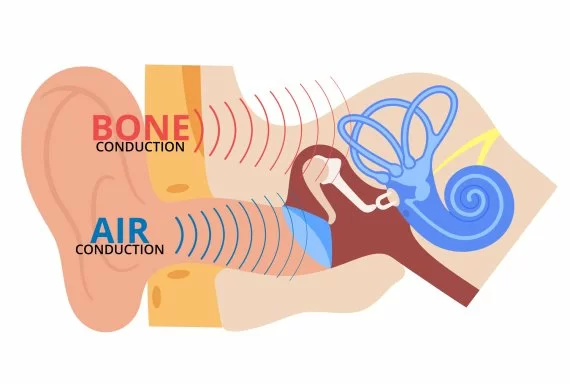
Contact the professionals at CavCom to discuss your noise environments and communication needs to find the solutions that are right for your workforce.
- Can I use my Talk Through Your Ears® or RadioGear® earset with my phone or MP3 player?
CavCom‘s Talk Through Your Ears® and RadioGear® earpieces may connect to other devices that have a 3.5mm or 2.5mm audio jack. The Talk Through Your Ears® function of the earset, however, is only achieved when used with the Talk Through Your Ears® control unit and a 2-way radio. A better option is CavCom‘s CellEarz™ earset or other accessories which are designed specifically for use with a personal phone or music device.

TeamTalk™
- How does the TeamTalk™ hands-free system work?
CavCom‘s TeamTalk™ hands-free line of products operate as "full-duplex" systems, meaning our units are able to transmit communications in both directions simultaneously. This means that users can speak and hear others at the same time without delay because there are two communication paths between them. Everyday examples are a cell phone conversation or a conference phone call with multiple people talking and listening at once. To eliminate confusion from too many people speaking at the same time, TeamTalk™ offers a push-to-talk mode where certain users must engage a PTT button to speak to others in the group.
- What is Full Duplex?
There are three types of communication channels. Simplex, Half-Duplex, and Full-Duplex. Each has its place in workplace communication. Knowing the advantages and disadvantages of each can help make a network more effective efficient and also help choose the most cost-effective solution.
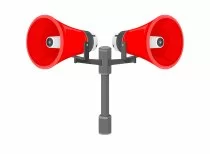
SIMPLEX
A simplex system can send messages in only one direction, from a designated transmitting device to a receiving device. An example would be a public announcement system or a musician's microphone connected to a loudspeaker.
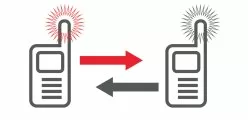 HALF-DUPLEX
HALF-DUPLEX
A half-duplex system is able to transmit communications in both directions, but not at the same time. Traditional two-way radios are half-duplex devices. The two-way radio has a push-to-talk (PTT) button which allows the user to transmit messages (if no one else is transmitting). Once you push the PTT, you can talk but cannot hear others until you release the PTT. Two-way radio users must take turns transmitting.
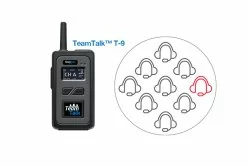
FULL-DUPLEX
A full-duplex system is able to transmit communications in both directions simultaneously. This means that users can speak and hear others at the same time, because there are two communication paths between them. A common example is a cell phone conversation or a conference phone call with multiple people talking and listening at once.
Read more on the advantages and ideal applications for full-duplex communication systems.
- How many people can use the TeamTalk™ hands-free system at once?
When hands-free (full duplex) communication is a must, TeamTalk™ allows users to communicate with each other live, without delay, and without having to press a button, just full-time talk/listen like a conference call. When hands-free communication is not needed, TeamTalk™ users may switch to "push-to-talk" mode and use a PTT button to transmit only when desired. The TeamTalk™ T-9 system simultaneously supports up to 9 full-duplex users "live" plus an unlimited number of additional users in PTT mode.
- Do radios and hands-free devices require an FCC license?
Professional two-way radios operate on radio frequencies that are regulated by the Federal Communications Commission (FCC). To transmit on these frequencies, you are asked to have a license issued by the FCC. This license is not required to purchase the radios but allows the FCC to keep track of how many users are using the frequency and what they are using it for. Most two-way radio users in businesses are required by the FCC to use licensed frequencies. Note that CavCom‘s TeamTalk™ line of hands-free communication devices do not require an FCC license.

Earsets & Headsets
- What is the difference between listening with one ear (monaural) vs. listening with both ears (binaural)?
For most people, binaural listening is superior. It probably comes as no surprise that just like vision is improved with two eyes, hearing is improved with two ears (and all the neural processing in between). Much research has been conducted on the combined effects of listening binaurally. The brain's processing of subtle differences in the time and level of signals coming from each ear provide for the ability to localize (tell which direction sounds are coming from). In addition, sounds don't need to be as loud when listening binaurally, especially in the presence of complex background noise. See CavCom‘s SoundBytes series to learn more: Effective 2-way Communication and Special Considerations for Workers with Hearing Loss.
- What does “volume-limited output” mean?
CavCom was founded on a commitment to improve workplace safety and productivity through innovative hearing protection and 2-way communication products. In addition to hazardous background noise, 2-way radios and lapel speaker mics can also be quite loud, potentially adding to workplace noise exposures. CavCom‘s goal from our first manufacturing run in 1997 was to limit volume outputs from 2-way radios by way of our accessories. Our volume-limited earsets produce significantly lower sound levels than typical accessories, particularly single-ear listening devices.
Output level is only one factor affecting potential risk to hearing. In addition to how loud a sound is, it's important to know how long and how often the exposure occurs. Controlling all factors will help reduce the risk of over-exposure.
When purchasing a personal communication device, CavCom recommends companies take into account 3 important features:
- Binaural (both ear) listening provides significant hearing advantages
- Output-limited accessories promote safer listening levels
- Adequate hearing protection is essential in order to minimize background noise and reduce risk of hearing loss
For more information about enhancing safety and effective communication in your workplace, see this article from CavCom‘s SoundBytes newsletter. Please contact us if you have questions or when we can be of assistance with your hearing conservation program.
- Does CavCom offer high-fidelity acoustic filters with your electronic earsets?
Yes, just like our complete line of filtered hearing protectors, most of CavCom‘s radio-monitoring/listening earsets are available with acoustic filters that you can tailor to your workplace noise levels. Many occupational noise exposures are under 95 dBA, and require 10 dB or less effective noise reduction. Too much protection, or "overprotection," occurs when a hearing protector reduces sounds to such low levels that it's difficult for the wearer to understand conversations and/or hear important workplace and warning sounds around them. CavCom‘s advanced acoustic filter technology is designed to provide appropriate protection, optimal comfort, and to maintain natural hearing of speech and other important sounds in the workplace.
- Is it true that bone-conduction headsets are safe?
That's a great question. These devices have recently become popular among consumers, because music and cell phone signals are transmitted to the inner ear by vibrating the skull, leaving the ear canals open to environmental sounds. We, too, are concerned about claims that bone-conduction headsets are "safe" because sounds "skip the eardrum."
First, let's be clear, it is the inner ear, or cochlea, that holds the nerve receptors for sound and is susceptible to traditional noise exposures, not the eardrum. If a sound is loud enough, whether received through air conduction or bone conduction, it can cause damage to the inner ear structures. Therefore, use of a bone-conduction headset is not inherently safe or unsafe – as with any listening device, it depends on how loud the signal is and how long the individual is exposed. We have heard other concerns that safety and health professionals should consider, including poor sound quality, discomfort, tinnitus, and "leakage," the ability for others to overhear transmissions. Personal listening devices also carry a risk of distraction and reduced ability to hear important warning sounds. Most employers do not allow music listening in the workplace, particularly in high noise areas. For more information on music headphones and OSHA advice, see another CavCom FAQ.

Contact the professionals at CavCom to discuss your noise environments and communication needs to find the solutions that are right for your workforce.
- My job can be boring. Is it OK if I listen to music headphones while I'm working?
Every situation is different - ask your health and safety coordinator if listening to music is allowed in your workplace. There are important safety concerns to consider:
- A music player is not a substitute for proper hearing protection. If you are exposed to hazardous noise (on or off the job), it's extremely important that you consistently wear properly fitted and adequate hearing protectors.
- A music player should not have loud outputs. Some music players have uncontrolled volume levels. The last thing you want to do is risk your hearing by listening to loud music for extended periods of time.
- Music players can cause distractions and pose a safety risk. Whether you're out for a walk or run in your local neighborhood, or on a worksite with moving vehicles and machinery, you need to understand that your ability to hear safety warnings may be compromised if you're distracted or if listening to headphones masks important sounds in your environment.
Take charge of your personal safety both on and off the job. Advice and interpretation from OSHA: OSHA Standard Interpretation, 2019.
- I've seen headsets and hearing protectors advertised as OSHA-certified or OSHA-compliant - what does this mean?
OSHA does not approve hearing protectors or communication devices. Instead, look for a Noise Reduction Rating (NRR) label, which indicates the device has been tested and rated for noise reduction according to EPA requirements. Make sure the NRR is sufficient for your noise environment. We also recommend volume-limited communication devices to reduce risk of loud outputs at the ear.
OSHA explanation:
"... some manufacturers may claim that their products are "OSHA approved" or "100% OSHA compliant." OSHA does not register, certify, approve, or otherwise endorse commercial or private sector entities, products, or services. Therefore, any such claims by a manufacturer are misleading."
- Can I use my Talk Through Your Ears® or RadioGear® earset with my phone or MP3 player?
CavCom‘s Talk Through Your Ears® and RadioGear® earpieces may connect to other devices that have a 3.5mm or 2.5mm audio jack. The Talk Through Your Ears® function of the earset, however, is only achieved when used with the Talk Through Your Ears® control unit and a 2-way radio. A better option is CavCom‘s CellEarz™ earset or other accessories which are designed specifically for use with a personal phone or music device.
- What is a noise-cancelling microphone, and how does it work?
A noise-cancelling microphone, such as those built into CavCom‘s Phantom™ and Classic™ headsets and many of our lapel speaker mics, is a sophisticated technology used to improve voice clarity in noisy environments. These devices work by comparing sound inputs from two microphones. The primary microphone faces your mouth to focus on your voice, and the secondary microphone is oriented in the opposite direction to pick up environmental/background noise. Then a digital algorithm is used to differentiate your voice from background, and to suppress the environmental noise. The result is a clearer voice signal transmitted to your listeners.
It's important to keep in mind that in order for noise-cancelling technology to work properly, correct microphone position is critical. When using a lapel microphone, speak directly into the mic (mouth within 1 inch of mic port). When using our headsets, bend or extend the boom microphone to be within 1 inch of your mouth (either directly in front or to the side of your mouth). If the microphone is too far away or if the mic is pointed in the wrong direction (at ceiling or floor for example), then the noise-cancelling circuitry will not be able to distinguish your voice from background noise. When used properly, a high quality noise-cancelling boom microphone provides a clear advantage in noisy environments... your listeners will thank you!
- Does CavCom‘s Talk Through Your Ears® system work off bone conduction?
No - CavCom‘s Talk Through Your Ears® technology captures acoustic voice signals present in the earcanal. So-called "bone conduction" microphones pick up physical vibrations via direct contact with body tissues.
- How do CavCom‘s high-fidelity filters work and how are they different from traditional filters and vents?
Rather than blocking airborne particles of different sizes like a respirator, an acoustic filter passes or blocks different frequencies of sound. Closing off the earcanal, such as when wearing a typical earplug, suppresses the earcanal's natural amplification of high frequency sounds. In addition, subtle leaks around a hearing protector let through more low frequency sounds (with larger wave lengths) than high frequency sounds (which have very short wave-lengths). Since the attenuation (reduction) of sound is less at low frequencies than high frequencies, the result of wearing a typical earplug or earmuff is that incoming sound is distorted or unbalanced – the "bass" louder than the "treble." When it comes to speech, high frequency consonants are attenuated more than lower frequency vowels, resulting in a perception of mumbled or muffled speech.
To achieve a more even, or "uniform," attenuation of sounds across all frequencies, it is necessary to control sound leakage around the hearing protector to ensure the correct attenuation at low frequencies. At the same time, attenuation at high frequencies must be limited in order to achieve a more balanced sound quality. Specialty high fidelity filters are made by using a membrane which seals the ear but at the same time vibrates well at high frequencies to achieve a consistent amount of sound reduction across low and high frequencies.
CavCom‘s high-fidelity acoustic filters use a patented membrane technology to achieve the desired uniform attenuation result. Compared to open vents or small resistive tube technology, our filters have a relatively large aperture that allows more natural sound transfer across the mesh layers inside the filter. Since the membrane is made of a breathable material, there is also less occlusion effect or "plugged up" sensation. Discomfort and over-protection are two of the main factors that result in failure to use hearing protection properly. Our advanced technology is tuned specifically for comfort and to maintain natural hearing of speech and other important sounds in the workplace.
Example: Compare the performance of CavCom‘s Hi-Fi filter to a traditional vent/tube filter in the graph below. Both hearing protectors have an overall NRR of 19, but the tube filter (plotted in red) provides an uneven amount of protection – very little reduction at low frequencies (pitches) and a great deal of reduction at high frequencies. This results in significant distortions, perceived as mumbled speech or a "boomy" quality to sounds. In contrast, the CavCom filtered hearing protector (plotted in blue) provides a fairly even/uniform amount of reduction throughout the frequency range. This preserves the integrity of the original speech signal or other environmental sounds outside the ear. Listeners report "crispness" of sounds and improved speech intelligibility.
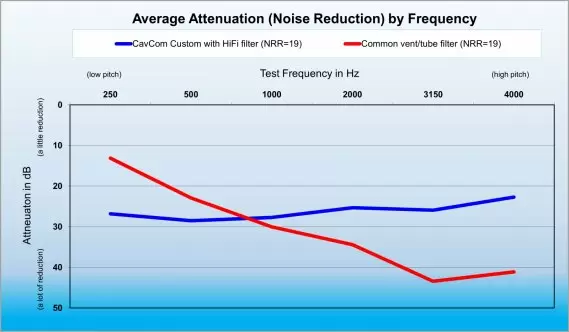
To learn more about avoiding OVERPROTECTION, read our SoundBytes article.
Contact CavCom to learn more about high fidelity filters to help improve communication, safety and efficiency in your moderate noise environments and hearing-critical jobs.
- How often should custom earplugs or earsets be replaced?
Not all custom products are the same. CavCom‘s custom earplugs and earsets are designed to last many years due to the considerable strength and durability of our design and materials. Replacement is not based on a set expiration date, but instead should be approached on an as-needed basis. Users should routinely check for wear and tear and proper seal of the ear. If an earpiece is broken or no longer adequately seals the ear, a replacement can be made.
In most cases, CavCom‘s digital storage of ear impressions allows remakes to be made from data already on file for each worker. A new ear impression may be needed to address any significant changes to a user's ear canals resulting from substantial weight change, injury to ear, etc.
For more information about custom products, see this article from CavCom‘s SoundBytes newsletter. Please contact us if you have questions or need guidance on ordering replacement custom products for your employees.
- Will wearing earplugs make my ears ring?
The short answer is "no." What is much more likely is that a person already has tinnitus (ringing in the ears), but doesn't notice the ringing so much when surrounded by typical day to day sounds. However, the ringing becomes much more noticeable when the environment is very quiet (such as at night) or when wearing earplugs or earmuffs. In either case, ambient/background noise is reduced, and ringing in the ears is now more audible and unfortunately, more annoying.
Because wearing earplugs or earmuffs is necessary to protect your hearing against loud noise, it may take some getting used to when first wearing hearing protectors. Most people report the tinnitus lessens as they get used to wearing hearing protection (and as ears are better protected against the effects of noise). The alternative is far worse – failing to wear hearing protection in loud noise can lead to permanent hearing loss and progressively worse tinnitus over time. If your tinnitus is severe or getting worse, check with a medical professional.
To learn more about causes, possible treatments, and work-arounds like white noise maskers, see our SoundBytes article.

Hearing Protection
- How do CavCom‘s high-fidelity filters work and how are they different from traditional filters and vents?
Rather than blocking airborne particles of different sizes like a respirator, an acoustic filter passes or blocks different frequencies of sound. Closing off the earcanal, such as when wearing a typical earplug, suppresses the earcanal's natural amplification of high frequency sounds. In addition, subtle leaks around a hearing protector let through more low frequency sounds (with larger wave lengths) than high frequency sounds (which have very short wave-lengths). Since the attenuation (reduction) of sound is less at low frequencies than high frequencies, the result of wearing a typical earplug or earmuff is that incoming sound is distorted or unbalanced – the "bass" louder than the "treble." When it comes to speech, high frequency consonants are attenuated more than lower frequency vowels, resulting in a perception of mumbled or muffled speech.
To achieve a more even, or "uniform," attenuation of sounds across all frequencies, it is necessary to control sound leakage around the hearing protector to ensure the correct attenuation at low frequencies. At the same time, attenuation at high frequencies must be limited in order to achieve a more balanced sound quality. Specialty high fidelity filters are made by using a membrane which seals the ear but at the same time vibrates well at high frequencies to achieve a consistent amount of sound reduction across low and high frequencies.
CavCom‘s high-fidelity acoustic filters use a patented membrane technology to achieve the desired uniform attenuation result. Compared to open vents or small resistive tube technology, our filters have a relatively large aperture that allows more natural sound transfer across the mesh layers inside the filter. Since the membrane is made of a breathable material, there is also less occlusion effect or "plugged up" sensation. Discomfort and over-protection are two of the main factors that result in failure to use hearing protection properly. Our advanced technology is tuned specifically for comfort and to maintain natural hearing of speech and other important sounds in the workplace.
Example: Compare the performance of CavCom‘s Hi-Fi filter to a traditional vent/tube filter in the graph below. Both hearing protectors have an overall NRR of 19, but the tube filter (plotted in red) provides an uneven amount of protection – very little reduction at low frequencies (pitches) and a great deal of reduction at high frequencies. This results in significant distortions, perceived as mumbled speech or a "boomy" quality to sounds. In contrast, the CavCom filtered hearing protector (plotted in blue) provides a fairly even/uniform amount of reduction throughout the frequency range. This preserves the integrity of the original speech signal or other environmental sounds outside the ear. Listeners report "crispness" of sounds and improved speech intelligibility.

To learn more about avoiding OVERPROTECTION, read our SoundBytes article.
Contact CavCom to learn more about high fidelity filters to help improve communication, safety and efficiency in your moderate noise environments and hearing-critical jobs.
- How often should custom earplugs or earsets be replaced?
Not all custom products are the same. CavCom‘s custom earplugs and earsets are designed to last many years due to the considerable strength and durability of our design and materials. Replacement is not based on a set expiration date, but instead should be approached on an as-needed basis. Users should routinely check for wear and tear and proper seal of the ear. If an earpiece is broken or no longer adequately seals the ear, a replacement can be made.
In most cases, CavCom‘s digital storage of ear impressions allows remakes to be made from data already on file for each worker. A new ear impression may be needed to address any significant changes to a user's ear canals resulting from substantial weight change, injury to ear, etc.
For more information about custom products, see this article from CavCom‘s SoundBytes newsletter. Please contact us if you have questions or need guidance on ordering replacement custom products for your employees.
- What is NRR or Noise Reduction Rating?
The Noise Reduction Rating (NRR) is a laboratory-derived single-number rating designed to characterize a hearing protector's noise reduction capabilities. The level of noise entering a person's ear, when the hearing protector is well-fitted and worn as directed, is approximated by the difference between the environmental noise level and the NRR (A-weighted environmental noise measurements must be corrected by subtracting 7 dB). A more precise estimate of field performance can be provided by Individual Fit Testing. This personalized test is performed under typical wear conditions and results in a Personal Attenuation Rating (PAR) for each worker.
For more information, see our SoundBytes article.
- What is the Personal Attenuation Rating (PAR)?
Personal Attenuation Rating (PAR) is a measure of hearing protector attenuation for each worker as determined by Individual Fit Testing. Individual Fit Testing is conducted for each employee using his/her own hearing protector as normally worn. OSHA, NIOSH and many professional organizations have long recognized that the laboratory-derived NRR is not a good predictor of actual hearing protector performance in the real world. Individual Fit Testing is now a recommended best practice for hearing conservation programs.
For more information, see our SoundBytes article.
- Why do OSHA formulas require us to subtract 7 dB from the Noise Reduction Rating (NRR)?
The 7dB reduction is a correction to be used with the employee's A-scale noise measurements. Most people are surprised to learn that the current NRR system was developed in the 1980s for use with C-scale workplace noise readings (the C-scale is a broad-spectrum frequency setting on sound level meters and dosimeters). Employee time-weighted-average noise exposures, however, must be calculated with an A-scale frequency setting on the sound measurement equipment (the A-scale is a weighted frequency setting more closely matched with human damage-risk criteria). The bottom line: if the employer has A-scale noise information, but not C-scale, then a 7 dB correction factor is required when using the NRR to assess hearing protection for the workplace.
For more information, check out our SoundBytes newsletter article, The NRR: What's in a Number?
- Does OSHA require hearing protection de-rating (cut the Noise Reduction Rating (NRR) in half)?
It is a common misconception that OSHA requires employers to "de-rate" NRRs by 50% when assessing adequacy of the hearing protector for the worker's noise exposure. Instead, OSHA only requires applying a 50% "safety factor" when considering whether engineering controls are to be implemented. For determining compliance with basic hearing conservation program requirements, however, OSHA does not require de-rating the NRR (or NRR - 7 when the company uses A-scale noise measurements).
The background is that de-rating schemes were developed decades ago and generally are no longer deemed helpful. Instead, individual hearing protection fit testing is now considered best practice for verifying real world performance.
For more information, see the explanation provided in the OSHA Technical Manual Section III: Chapter 5, Appendix F: Noise Reduction Rating
Read more in our SoundBytes articles:
- Why should we conduct hearing protection fit testing?
Hearing protection fit testing is now considered best practice for any occupational health and safety program. Benefits of fit testing include:
- Selecting the style and size hearing protector that is appropriate for each worker's noise exposure, work environment and personal preferences
- Verifying the amount of protection provided in the real world instead of relying on outdated de-rating calculations of laboratory NRR values
- Proactively identifying workers with poorly-fitting hearing protectors who are at increased risk of developing hearing loss/shifts in hearing
- Improving employee knowledge of hearing protector fit and use, leading to greater motivation for personal safety
- Accomplishing required follow-up in cases of Standard Threshold Shift (STS) and other significant shifts in hearing by verifying refit and retraining of hearing protection devices
- Producing written documentation of your hearing loss prevention efforts
For more information:
- How often should we conduct hearing protection fit testing?
To best accomplish your hearing loss prevention goals, most companies follow these general rules of thumb for fit testing/retesting:
- new employees and those new to the hearing conservation program
- when a worker changes to a new type of hearing protector
- when an employee has shown Standard Threshold Shift (STS) or other significant shift in hearing
- in cases of physical changes to the ear such as injury, surgery, etc. that affect the fit of the hearing protector
- when a worker expresses concerns or complaints about hearing protector fit/attenuation
- some employers conduct routine retesting (every few years for example) for all employees, while others choose to target routine retests only for individuals with very high noise exposures (using dual hearing protection), for those working hearing-critical jobs, or those who have experienced past shifts in hearing or other concerns
For more information:
Individual Fit Testing for Hearing Protectors
How Individual Fit Testing Can Complement Your Hearing Conservation Program
- Is it true that OSHA requirements do not apply to custom hearing protectors?
Although it is true that a well-made custom hearing protector typically performs better in the real world than pre-sized or one-size-fits-most formable earplugs, we can assure you there is no formal "exemption" policy from OSHA for custom products.
We know hearing protector attenuation is an important factor in the success of your hearing conservation program. That's why CavCom strongly recommends conducting individual fit testing to obtain Personal Attenuation Ratings (PARs), not relying solely on mathematical estimates of laboratory Noise Reduction Ratings (NRRs).
For further guidance on assessing the amount of hearing protection your workers are receiving, see these article from CavCom‘s SoundBytes newsletter:
NRR De-Rating Schemes are Outdated
Please contact us if you have questions or would like guidance on hearing protection attenuation and individual fit testing.
- Will wearing earplugs make my ears ring?
The short answer is "no." What is much more likely is that a person already has tinnitus (ringing in the ears), but doesn't notice the ringing so much when surrounded by typical day to day sounds. However, the ringing becomes much more noticeable when the environment is very quiet (such as at night) or when wearing earplugs or earmuffs. In either case, ambient/background noise is reduced, and ringing in the ears is now more audible and unfortunately, more annoying.
Because wearing earplugs or earmuffs is necessary to protect your hearing against loud noise, it may take some getting used to when first wearing hearing protectors. Most people report the tinnitus lessens as they get used to wearing hearing protection (and as ears are better protected against the effects of noise). The alternative is far worse – failing to wear hearing protection in loud noise can lead to permanent hearing loss and progressively worse tinnitus over time. If your tinnitus is severe or getting worse, check with a medical professional.
To learn more about causes, possible treatments, and work-arounds like white noise maskers, see our SoundBytes article.
- What are noise-cancelling hearing protectors?
We sometimes hear about Active Noise Reduction (ANR), or "noise cancellation," in association with electronic earmuffs. This electronic technology uses a microphone to pick up incoming sound, a digital processor to invert the phase of the incoming sound, and a speaker to reintroduce the altered sound. The intent is to reduce the resulting sound levels by "cancelling" as much of the original sound wave as possible.
Because of the practicalities of basic acoustics, however, this technique works well only for noises with relatively long wave-lengths, that is, low frequency (pitch) sounds. In practice, ANR technologies effectively reduce levels when sounds are about 500 Hz and below. Consumer headsets are popular for reducing annoying, but not hazardous, day-to-day noise from cars, airplanes, and so on. In industry, hazardous noise environments are generally comprised of many frequencies, or "broad band" sound. Although ANR can often supplement noise reduction and hearing protection efforts in high noise environments, the technology typically cannot stand alone. ANR is usually applied only in combination with traditional hearing protection methods (such as earplugs and earmuffs) that are effective at blocking a wide frequency range of noise.
- What is the Noise Reduction Rating (NRR) for double hearing protection?
The OSHA Technical Manual allows employers to add 5 dB for the second hearing protector when an earmuff and earplug are worn together. An example: if wearing an earplug with an NRR of 25 together with an earmuff (also with an NRR of 25), expect a combined NRR of 30. Keep in mind, however, that this rule of thumb is a general estimate. To learn more about the ins and outs of dual hearing protection, and how to improve accuracy of your estimates, see this SoundBytes article.
- Does CavCom offer high-fidelity acoustic filters with your electronic earsets?
Yes, just like our complete line of filtered hearing protectors, most of CavCom‘s radio-monitoring/listening earsets are available with acoustic filters that you can tailor to your workplace noise levels. Many occupational noise exposures are under 95 dBA, and require 10 dB or less effective noise reduction. Too much protection, or "overprotection," occurs when a hearing protector reduces sounds to such low levels that it's difficult for the wearer to understand conversations and/or hear important workplace and warning sounds around them. CavCom‘s advanced acoustic filter technology is designed to provide appropriate protection, optimal comfort, and to maintain natural hearing of speech and other important sounds in the workplace.
- My job can be boring. Is it OK if I listen to music headphones while I'm working?
Every situation is different - ask your health and safety coordinator if listening to music is allowed in your workplace. There are important safety concerns to consider:
- A music player is not a substitute for proper hearing protection. If you are exposed to hazardous noise (on or off the job), it's extremely important that you consistently wear properly fitted and adequate hearing protectors.
- A music player should not have loud outputs. Some music players have uncontrolled volume levels. The last thing you want to do is risk your hearing by listening to loud music for extended periods of time.
- Music players can cause distractions and pose a safety risk. Whether you're out for a walk or run in your local neighborhood, or on a worksite with moving vehicles and machinery, you need to understand that your ability to hear safety warnings may be compromised if you're distracted or if listening to headphones masks important sounds in your environment.
Take charge of your personal safety both on and off the job. Advice and interpretation from OSHA: OSHA Standard Interpretation, 2019.
- I've seen headsets and hearing protectors advertised as OSHA-certified or OSHA-compliant - what does this mean?
OSHA does not approve hearing protectors or communication devices. Instead, look for a Noise Reduction Rating (NRR) label, which indicates the device has been tested and rated for noise reduction according to EPA requirements. Make sure the NRR is sufficient for your noise environment. We also recommend volume-limited communication devices to reduce risk of loud outputs at the ear.
OSHA explanation:
"... some manufacturers may claim that their products are "OSHA approved" or "100% OSHA compliant." OSHA does not register, certify, approve, or otherwise endorse commercial or private sector entities, products, or services. Therefore, any such claims by a manufacturer are misleading."

Hearing Conservation Programs
- How often do workers need to be exposed to noise throughout the year before we are required to include them in our company's hearing conservation program?
OSHA's interpretation is stringent: only one day of noise exposure in excess of 85 dBA time-weighted average triggers inclusion in the hearing conservation program. But hearing loss prevention, like any other safety and health program, is not just a regulatory matter. For practical reasons and best practice, many companies provide protections to employees with only occasional noise exposures, as well as temporary workers and contractors. For more information, see NIOSH's webpage and OSHA's topic page.
- Does working in noise increase the risk of accidents?
That's a great question. The risk of hearing loss due to loud noise is well known. But other potential risks from noise are not so clear. Is loud noise also to blame for accidents in the workplace? Are all workers at higher risk, or perhaps just those individuals who are hard of hearing? To learn more, see this article from CavCom‘s SoundBytes newsletter.
- What is the difference between a hearing loss and a hearing shift?
Terminology for describing results of audiometric (hearing) tests can be confusing. Conventions/common uses can vary across settings and countries. In general, "hearing loss" is a term often used interchangeably with "hearing impairment" or "hearing difficulty," referring to hearing test results outside a pre-described normal range. That is, the tone(s) has to be louder than expected for the person to detect that tone and respond. The louder the tones need to be to elicit a response, then the more hearing loss the person is said to have. Hearing loss can be mild to severe, occur in one or both ears, affect only certain tones (frequencies), and can be due to many reasons. It is important to keep in mind that the term "hearing loss" describes results of a given audiogram and does not reflect how much the person's hearing ability may have changed over time.
A "shift" in hearing, on the other hand, is a term used to describe situations when a person's hearing ability has changed (usually for the worse). A shift cannot be determined by looking at one hearing test. Instead, a shift is calculated by comparing one hearing test to a previous or baseline audiogram. Regulatory agencies such as OSHA typically have a very strict definition for classifying when a change of hearing is significant enough to be called a shift (Standard Threshold Shift) and in need of hearing conservation program action. A different regulation, and different criteria, apply when determining if a shift in hearing is signficant enough to report on the OSHA Log.
It is important to remember that hearing loss and hearing shift describe two separate, and often independent, aspects of hearing function. It is possible for someone to have a severe hearing loss or impairment, but have no change or shift in hearing over a given timeframe. Likewise, it is possible for someone with very good hearing to show a significant shift while their overall hearing ability remains within the normal range (i.e. no "hearing loss"). Of course, the ultimate goal of an effective hearing conservation program is to prevent shifts, and in turn prevent hearing loss from developing or getting worse.
- What is the combined noise level when two machines/noise sources that each measure 90 dBA individually are running simultaneously?
Actual sound levels must be measured with a calibrated sound level meter or dosimeter and will vary depending on equipment operation and the immediate physical environment, but a reasonable prediction is about 93 dBA. Decibels are calculated using a logarithmic scale, so they cannot be added, or subtracted, arithmetically. The human ear can detect an amazingly broad range of sound pressures, from very tiny changes in air pressure such as a rustling leaf to immense pressure waves, such as those associated with a roaring jet engine. For this reason, scientists came to agree on a more manageable method for computing sound levels. Sound pressure measurements are converted to decibels using a logarithmic scale in order to compress numeric values into a smaller, and less unwieldy, range.
Based on formulas used for calculating decibels, doubling the sound pressure results in a 3 dB increase. Halving sound pressure results in a 3 dB decrease. In our example, two noise sources each producing 90 dBA combine to produce approximately 93 dBA. For this reason, it's important to remember that small increases or decreases in dB can actually reflect large changes in sound energy. Another way to think about it, increasing noise by 3 dB could indicate a significant increase in noise exposure and hazard. In turn, using an engineering noise control or a more effective hearing protector to reduce an employee's noise exposure by 3 dB could be a significant achievement!
- What is NRR or Noise Reduction Rating?
The Noise Reduction Rating (NRR) is a laboratory-derived single-number rating designed to characterize a hearing protector's noise reduction capabilities. The level of noise entering a person's ear, when the hearing protector is well-fitted and worn as directed, is approximated by the difference between the environmental noise level and the NRR (A-weighted environmental noise measurements must be corrected by subtracting 7 dB). A more precise estimate of field performance can be provided by Individual Fit Testing. This personalized test is performed under typical wear conditions and results in a Personal Attenuation Rating (PAR) for each worker.
For more information, see our SoundBytes article.
- Why should we conduct hearing protection fit testing?
Hearing protection fit testing is now considered best practice for any occupational health and safety program. Benefits of fit testing include:
- Selecting the style and size hearing protector that is appropriate for each worker's noise exposure, work environment and personal preferences
- Verifying the amount of protection provided in the real world instead of relying on outdated de-rating calculations of laboratory NRR values
- Proactively identifying workers with poorly-fitting hearing protectors who are at increased risk of developing hearing loss/shifts in hearing
- Improving employee knowledge of hearing protector fit and use, leading to greater motivation for personal safety
- Accomplishing required follow-up in cases of Standard Threshold Shift (STS) and other significant shifts in hearing by verifying refit and retraining of hearing protection devices
- Producing written documentation of your hearing loss prevention efforts
For more information:
- How often should we conduct hearing protection fit testing?
To best accomplish your hearing loss prevention goals, most companies follow these general rules of thumb for fit testing/retesting:
- new employees and those new to the hearing conservation program
- when a worker changes to a new type of hearing protector
- when an employee has shown Standard Threshold Shift (STS) or other significant shift in hearing
- in cases of physical changes to the ear such as injury, surgery, etc. that affect the fit of the hearing protector
- when a worker expresses concerns or complaints about hearing protector fit/attenuation
- some employers conduct routine retesting (every few years for example) for all employees, while others choose to target routine retests only for individuals with very high noise exposures (using dual hearing protection), for those working hearing-critical jobs, or those who have experienced past shifts in hearing or other concerns
For more information:
Individual Fit Testing for Hearing Protectors
How Individual Fit Testing Can Complement Your Hearing Conservation Program

Two-Way Radios & FCC
- Is there a deadline from the FCC for upgrading our 2-way radios to digital?
The short answer for general industry/business is NO. You may continue to operate your 2-way radios in analog mode. The FCC has indicated their intention is to eventually have everyone operating at 6.25 kHz (digital) frequencies, but they have not yet provided a deadline. All the same, digital radios have many advantages and extra features you may find helpful for your business.
- Do radios and hands-free devices require an FCC license?
Professional two-way radios operate on radio frequencies that are regulated by the Federal Communications Commission (FCC). To transmit on these frequencies, you are asked to have a license issued by the FCC. This license is not required to purchase the radios but allows the FCC to keep track of how many users are using the frequency and what they are using it for. Most two-way radio users in businesses are required by the FCC to use licensed frequencies. Note that CavCom‘s TeamTalk™ line of hands-free communication devices do not require an FCC license.
- Why do I need an FCC licensed frequency for my business?
The FCC requires most professional two-way radio users to use FCC licensed frequencies in their business operations. Licensing helps prevent multiple businesses in the same area from using the same frequencies. When you apply for a license, a search will be done in the FCC database for unused frequencies in your area to assign to you.
- How many frequencies do you get from a license?
The number and type of frequencies on a license are dependent on what the user applies for. CavCom‘s staff will work with your team to determine the right number and type of frequencies depending on your needs.
- How many channels does a radio have?
A "channel" on a two-way radio is a talk group (group of two-way radio users that communicate). The number of channels on a two-way radio is dependent on the radio (radios typically allow for anywhere between 16 and hundreds of channels), the FCC license and the two-way radio users' needs (how many channels do you need/want).
- What is the difference between analog vs digital radios?
Analog: Analog radios have provided a simple and easy-to-use experience for users, but as many businesses continue to evolve the need for clearer voice, expanded features and coverage have increased. With analog radios, every noise picked up by the microphone is transmitted, making it difficult for users to understand each other in noisy environments. Radio interference creates static on analog radios and makes the conversation less intelligible. Voice gets garbled and the message must be repeated, especially the closer you move to the boundaries of coverage. Also, analog radios typically allow for only one two-way conversation at a time per channel, limiting your team's ability to collaborate.
Digital: Clear communication is critical to operating efficiently and digital two-way radios offer advantages compared to analog including, clearer voice quality, increased radio capacity, better signal coverage and extended battery life. Built-in error correction capabilities maintain clear voice transmission as well as remove background noise, static and voice distoration even at the far reaches of coverage. Digital encoding aids in delivering clear voice in extreme conditions. Capacity expansion allows you to double the capacity of your existing 12.5kHz channel which can lower licensing costs. Digital radios provide up to 40% longer battery life allowing radio users the ability to communicate the entire day without recharging.
- What is encryption?
In two-way radios, encryption modifies a voice signal using a coding algorithm. This algorithm is controlled by an encryption key. The encryption key is used by the transmit and receive radios to enable the voice signal to be coded and decoded for both radios. Encryption is used with frequencies to further privatize radios communications.
- VHF or UHF?
VHF stands for "Very High Frequency" and UHF stands for "Ultra High Frequency." UHF has two ranges, low band (operates on 378-512 MHz) and high band (operates on 764-870 MHz). VHF also has two ranges, low band (49-108 MHz) and high band (169-216 MHz). Both bandwidths have distinct advantages and disadvantages depending on the application. VHF is typically better for long ranges with no obstructions (walls, equipment) and is best for use outside in open spaces. UHF frequencies are preferred inside facilities because the frequencies are shorter and can move around corners and turns more effectively. Most two-way radio users would benefit from UHF.
- What is the transmission range for radios?
Transmission range varies per model. Transmission range can be calculated based on the environment it will be used in, antenna, obstructions, and power of the radios. CavCom‘s field technicians can do a site and range evaluation to find the right radios for your facility.
- Is two-way radio wattage important?
The stronger the signal strength, the more it can withstand weakening when it passes through obstacles. Signal strength is mainly a result of a radio's power output, measured in watts. Commercial radio stations typically broadcast at 50,000 or 100,000 watts. Compare that to a handheld two-way radio which uses between 1/2 - 5 watts. You can see there is a big difference.
- What does a repeater do?
A two-way radio repeater is an infrastructure built to amplify your communication – and has a receiver, transmitter, and a base station antenna. With this technology combination, the coverage area in workplaces, and the building penetration for coverage, is greater. Typically, two-way radio repeaters are used in very large workspaces, the repeater allows the two-way radio transmitting signals at higher powers, which improves facility communication. But not every workplace requires a radio repeater.
- Why do I need a repeater?
5 Reasons you might need a two-way radio repeater
- Poor Coverage
- Facility layout and barriers
- Coordination of teams on different frequencies
- Unique applications that require specific infrastructures
- Wide Area Coverage
- What is the best way to protect my radio?
The absolute best way is to use a combination of a holster and in-ear or speaker mic technology. This way your radio stays on your belt and you talk into the speaker mic clipped to your lapel. Companies that buy holsters and speaker mics send in their radio for repair less than half as often as companies that don't.
- Replacements and spare parts?
If you need replacement parts such as knobs, screws, latches, or accessories please give us a call. We repair most two-way radio models and offer quick and affordable repair services even if you didn't purchase it from us. Take look at our services.
- Does the Talk Through Your Ears® system require an FCC license?
No. The CavCom Talk Through Your Ears® system is an accessory to your two-way radio. Your two-way radio, however, must be operated under an FCC license. Please contact CavCom @ 1-866-547-4988 for assistance.
- How does the TeamTalk™ hands-free system work?
CavCom‘s TeamTalk™ hands-free line of products operate as "full-duplex" systems, meaning our units are able to transmit communications in both directions simultaneously. This means that users can speak and hear others at the same time without delay because there are two communication paths between them. Everyday examples are a cell phone conversation or a conference phone call with multiple people talking and listening at once. To eliminate confusion from too many people speaking at the same time, TeamTalk™ offers a push-to-talk mode where certain users must engage a PTT button to speak to others in the group.
- What is Full Duplex?
There are three types of communication channels. Simplex, Half-Duplex, and Full-Duplex. Each has its place in workplace communication. Knowing the advantages and disadvantages of each can help make a network more effective efficient and also help choose the most cost-effective solution.

SIMPLEX
A simplex system can send messages in only one direction, from a designated transmitting device to a receiving device. An example would be a public announcement system or a musician's microphone connected to a loudspeaker.
 HALF-DUPLEX
HALF-DUPLEX
A half-duplex system is able to transmit communications in both directions, but not at the same time. Traditional two-way radios are half-duplex devices. The two-way radio has a push-to-talk (PTT) button which allows the user to transmit messages (if no one else is transmitting). Once you push the PTT, you can talk but cannot hear others until you release the PTT. Two-way radio users must take turns transmitting.

FULL-DUPLEX
A full-duplex system is able to transmit communications in both directions simultaneously. This means that users can speak and hear others at the same time, because there are two communication paths between them. A common example is a cell phone conversation or a conference phone call with multiple people talking and listening at once.
Read more on the advantages and ideal applications for full-duplex communication systems.
- How many people can use the TeamTalk™ hands-free system at once?
When hands-free (full duplex) communication is a must, TeamTalk™ allows users to communicate with each other live, without delay, and without having to press a button, just full-time talk/listen like a conference call. When hands-free communication is not needed, TeamTalk™ users may switch to "push-to-talk" mode and use a PTT button to transmit only when desired. The TeamTalk™ T-9 system simultaneously supports up to 9 full-duplex users "live" plus an unlimited number of additional users in PTT mode.
- What is a noise-cancelling microphone, and how does it work?
A noise-cancelling microphone, such as those built into CavCom‘s Phantom™ and Classic™ headsets and many of our lapel speaker mics, is a sophisticated technology used to improve voice clarity in noisy environments. These devices work by comparing sound inputs from two microphones. The primary microphone faces your mouth to focus on your voice, and the secondary microphone is oriented in the opposite direction to pick up environmental/background noise. Then a digital algorithm is used to differentiate your voice from background, and to suppress the environmental noise. The result is a clearer voice signal transmitted to your listeners.
It's important to keep in mind that in order for noise-cancelling technology to work properly, correct microphone position is critical. When using a lapel microphone, speak directly into the mic (mouth within 1 inch of mic port). When using our headsets, bend or extend the boom microphone to be within 1 inch of your mouth (either directly in front or to the side of your mouth). If the microphone is too far away or if the mic is pointed in the wrong direction (at ceiling or floor for example), then the noise-cancelling circuitry will not be able to distinguish your voice from background noise. When used properly, a high quality noise-cancelling boom microphone provides a clear advantage in noisy environments... your listeners will thank you!

Customer Service
- How can I contact the customer service department?
- Hours: 8:00am to 5:00PM CST
- Phone: 866-547-4988
- Fax: 218-547-4913
- Email: cavcomservice@cavcominc.com
- Physical & Mailing Address: 1872 Industries Lane - Walker, MN 56484
- Where do I send my repairs?
CavCom offers fast repairs for your convenience.
- Please complete and submit the repair form: CavCom Product Repair Form
- Send us your equipment with the completed repair form included in the box.
- Ship repairs to: CavCom - Attn: Repairs - 1872 Industries Lane - Walker, MN 56484


